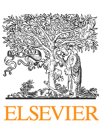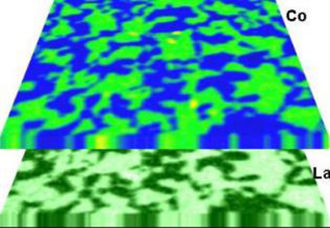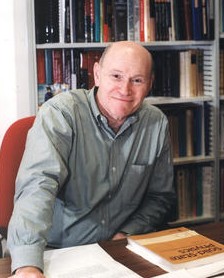PALE:ClassicArticles/GMR
From NSDLWiki
Primary Articles Learning Environment (PALE) NSDL Classic Articles in Context. Issue 2, December 2008.
An Idiosyncratic History of Giant Magnetoresistance
by Peter M. Levy.
Introduction
Giant magnetoresistance (GMR) was discovered independently in 1988 by Albert Fert, of France, and Peter Grünberg, of Germany, who shared the Nobel Prize in Physics in 2007 for their work. The GMR effect refers to a large change in the electrical resistance of a metal when one changes the internal configuration of the magnetization. To understand the origins of this phenomenon we will have to understand what constitutes an electric current and how it can be controlled by the orientation of the magnetism of one part of a conductor relative to other parts.
One of the first models of conduction in solids was devised by Paul Drude in 1900 just three years after J.J. Thomson’s discovery of the electron (Ashcroft & Mermin, 1976). It was based on the kinetic theory of gases and considered a good conductor, such as a metal, as a “gas of electrons” immersed in a background of positively charged ions. Under ambient conditions the electrons move randomly and collide with one another as well as with the ions. Upon application of an electric field the electrons are accelerated and eventually collide with one another and the quasi-stationary ions. After suffering a repetition of these acceleration-collision processes one can define an average time τ between collisions, and an average velocity υ attained. In similitude to Ohm’s law V=IR* one can define a resistivity, ρ, as the constant of proportionality between the electric field and current density, E=ρJ. Based on his model, Drude found that the inverse of this resistivity, i.e., the conductivity, σ is
where n is the number of electrons per unit volume, and e and m are the charge and mass of an electron, respectively. Whereas e and m are known, n and could not be calculated until after we had a quantum theory of solids, which explained wave-like properties of electrons, including reflection and defraction, that play a role in the behavior of solid materials.
(* Note: some texts write Ohm’s law as E=IR, where E refers to electromotive force.)
Pauli’s exclusion principle and Fermi-Dirac statistics hold that only one electron can occupy a quantum state; it followed, then, that n electrons in the solid occupy energy states up to Fermi energy (Ashcroft & Mermin 1976), the energy of the highest occupied quantum state,
where ![]() is Planck’s constant.*
is Planck’s constant.*
(* Note: some texts write Planck’s Constant as simply “h.” Note that  )
)
Even at zero temperature, the electrons at the Fermi energy, which is equivalent to about 80,000 Kelvin in a metal such as copper (Cu), are moving about the solid at very large velocities, albeit randomly so that this does not change the average time between collisions . The statistics do mandate that electrons scattered by a collision out of one state can only go into an empty state, so that only the electron states around the Fermi energy, which is the demarcation point between filled and empty states, are relevant to electron conduction in solids; it follows that only the density of electron states at the Fermi level
is relevant. It follows that even at room temperature only a very tiny fraction ![]() of the n electrons, 300/80,000 or one in three hundred, participate in electrical conduction.
of the n electrons, 300/80,000 or one in three hundred, participate in electrical conduction.
A quantum theory of electrons in a periodic structure, i.e., a solid, was necessary to understand why some solids, like metals, are good conductors, whereas others are insulators or semiconductors. In periodic solids, the electron energy states developed gaps in which no electron states exist; when the energy of the Fermi level falls in the region of a gap no electron states exist, and one has a semiconductor or insulator, otherwise the Fermi energy lies within a band of allowable energy states for metals. Even when electrons in solids occupy allowable states they do not move as if they were free. The multiple scattering of electrons in a periodic solid, while it does not give rise to resistance, does alter their velocity. (Ashcroft & Mermin, 1976) This is indicated by an effective mass m*, which connotes how tightly bound an electron is to its parent site. It is related to the curvature or slope of the electron’s energy versus its momentum; so that heavier mass means a slower traveling electron.
This latter point is precisely the key to how the magnetism of the ferromagnetic transition-metals, such as Iron (Fe), Nickel (Ni) and Cobalt (Co), affect their electrical conduction. The degree to which an electron remains bound to the atom from which it was liberated determines the degree to which the intra-atomic Coulomb forces act on the electron; therefore in addition to controlling its effective mass this localization controls the degree to which local atomic moment, which arise from intra-atomic quantum mechanical exchange interactions, survive in a metal.
In many metals the energy of localized electrons that carry the atomic moments of the atoms are far removed from the Fermi energy, e.g., Cu, Silver (Ag) and Gold (Au). However there exist atoms in which one starts to fill outer shells before completing to fill inner ones. The first such series are the 3d transition-metals, which fill the 4s shell before completing the 3d; in particular for Co, Fe and Ni the energy of the 3d electrons, which carry the magnetic moment of these ferromagnetic metals, coexist with the 4s electrons at the Fermi level (energy). This has two ramifications: the 3d electrons have a high effective mass compared to those of the quasi-free 4s, and the density of states for 3d electrons depend on whether the electron’s spin is parallel or antiparallel to the net magnetization. This is well illustrated by Co, where only minority electrons, meaning those with their spin antiparallel to the magnetization, exist at the Fermi level. The 3d band with majority electrons is completely filled and lies below ![]() (see the Fig. 1). As seen in Figure 1, the density of states of the narrow 3d band lies completely below the
(see the Fig. 1). As seen in Figure 1, the density of states of the narrow 3d band lies completely below the ![]() for nonmagnetic Cu whereas for Co, a good ferromagnetic metal, the minority 3d band exists at
for nonmagnetic Cu whereas for Co, a good ferromagnetic metal, the minority 3d band exists at ![]() .
.
Figure 1. Spin-projected densities of states for Co and Cu: the differently shaded gray areas indicate the amount of s, p, and d states (Levy & Mertig, 2002). This image originally appeared as figure 2.6 in Spin Dependent Transport in Magnetic Nanostructures, S. Maekawa & T. Shinjo (Eds.) London: Taylor and Francis (2002) pg. 81 and is included with permission of the publisher.
Progress of Discovery: Investigations of Record
In 1935-1936 Neville Mott developed a model for the “anomalous” electrical resistivities of the ferromagnetic transition-metals (Mott, 1935 & 1936), which posited that 4s electrons carry the current while the 3d electrons at the Fermi level act as localized scatterers; it followed that, inasmuch as minority 3d electrons exist at EF, the resistivity of the minority Co electrons is far higher than for majority electrons and the overall resistivity for Co would be larger than that for Cu.
Some thirty years later Albert Fert corroborated the details of Mott’s model, and further elucidated the picture of conduction in the transition-metals by observing: “If the magnetic moment of an impurities is antiparallel to the host magnetization, or if the moments of ternary impurities are antiparallel, the resistivity is higher than when they are parallel” (A. Fert, personal communication, March 2008 concerning J Phys, F: Metal Physics paper of Fert & Campbell, 1976). The question that remained was how could one, other than by preferentially alloying a metal with different impurities, switch the alignment of magnetic moment from parallel to antiparallel? The answer was to sandwich a layer of a nonmagnetic metal between magnetic layers, that is, to deposit, layer by layer, atoms which form a magnetic metal followed by atoms that form a nonmagnetic spacer. In this manner one can uncouple magnetic layers, and rotate their magnetizations relative to one another.
The layering of different metals was no mean feat, because of the chemical affinity between the atoms to intermix at the interface between different metals; this lead to their interdiffusing so that it was very difficult to achieve a sharp demarcation between adjacent layers.
It took another decade to master the growth of multilayers of magnetic and nonmagnetic metals, and in 1986, Peter Grünberg, amongst others, grew a Fe/Cr/Fe trilayer structure in which the Fe layers were aligned antiparallel (antiferrromagnetically) before applying a field (Grünberg, Schreiber, Pang, Brodsky, & Sowers, 1986). This was the missing ingredient to achieve GMR, because external magnetic fields only can switch an antiparallel configuration to parallel, and two years later both Albert Fert and Peter Grünberg announced their discovery of GMR (Baibich, et al, 1988 and Binasch, Grünberg, Saurenbach, & Zinn, 1989). Grünberg used a Fe/Cr/Fe trilayer and found the resistance of his sandwich was lower by 1.5% when the magnetic layers were parallel when he applied 0.15 Tesla, while Fert used a Fe/Cr superlattice, a repetition of the basic Fe/Cr motif, and found about a 50% change in the resistance, albeit for 2 Tesla.
This discovery was immediately recognized for its potential application as a magnetoresistive sensor in the read head of hard disk drives in computers to read magnetic information imprinted on the disk. And in 1997, the first commercially available GMR read heads were developed by IBM. GMR made it possible to extend Moore’s Law for computer memories that suggests, loosely interpreted, magnetic memories densities double every 12 months. Perhaps more generally, it spawned a new field of research called spintronics, which denotes the control of electrical conduction through the spin of the electron, as distinguished from electronics which controls conduction by the charge of the electron. By varying the magnetic metal and the impurities which scatter the current one controls the resistivity of metallic structures in which conduction takes place in two spin channels, majority and minority, and where one can switch channels by flipping the magnetic configuration from parallel to antiparallel by applying a modest external field and thereby altering the resistivity. Today, this is one of the foremost areas of research and development in Physics.
As I will examine in this particular collection of critical research articles, spanning seven decades, the work leading up and occurring subsequent to the demonstration of GMR has stimulated many other strands of scientific inquiry. For example, inasmuch as the resistance depends on the background magnetization, the inverse effect (known as spin transfer torque), that the current changes the magnetic configuration, was predicted in 1996 and found in 2000. This has made it feasible to reset the active memory in computers by the same electric circuits that are used to read the information. While GMR was found in metallic multilayers a similar phenomenon was found in 1972 in the tunneling of currents across magnetic grains in Ni films; this was rapidly followed by the observation of a 14% change in the resistance of a Fe/Germanium (Ge)/Fe trilayer (now known as a magnetic tunnel junction), as the Fe magnetic electrodes are switched from antiparallel to parallel. This is known as tunneling magnetoresistance (TMR). In these junctions, the insulating Ge spacer allows electrons to quantum mechanically tunnel across; whereas for metallic spacers, electrons travel across a multilayer through itinerant states. It took another two decades to obtain reproducible results on these tunnel junctions, and the work on understanding the various mechanisms that produce GMR has helped us understand TMR, as well as their relation to one another. When theorists fully understood TMR they were able to predict in 2001 a TMR ratio of 1000% for Fe/Manganese Oxide (MgO)/ Fe; recently experimentalists were able to find up to 600% for these magnetic tunnel junction, which is truly spectacular.
The knowledge obtained from electrical conduction in magnetic metals has lead to our quest for injecting spin currents into otherwise nonmagnetic materials, such as carbon nanotubes and graphene. This is at the very frontier of research on the application of spintronics and is another story best left for the future.
What is clear today is that GMR rejuvenated our study of magnetism and demonstrated that sometimes research in promising areas of pure science slip into hibernation for a period of time only to emerge decades later and lead to a Nobel Prize.
Discussion Questions (General)
Questions specific to each article appear with interpretive essays
a. What roles does the Pauli exclusion principle play in electron conduction in metals?
b. Why did it take nearly two decades between Fert’s work on the role of the electron’s spin on conduction in ferromagnetic metals and the discovery of GMR?
References
Ashcroft, N.W., & Mermin, N.D. (1976) Solid State Physics. New York. Holt, Rinehardt and Winston.
Baibich, M.N., Broto, J.M., Fert, A., Nguyen Van Dau, F., Petroff, F., Eitenne, P., Creuzet, G., Friederich, A., & Chazelas, J. (1988) Phys. Rev. Lett. 61, 2472 and Binasch, G., Grünberg, P., Saurenbach, P., & Zinn W. (1989) Phys. Rev. B 39, 4828.
Grünberg, P., Schreiber, R., Pang, Y., Brodsky, M.B., & Sowers, H. (1986) Phys. Rev. Lett. 57, 2442.
Fert, A., & Campbell, I.A. (1976) J.Phys. F:Metal Phys. 6,849.
Levy, P.M., & Mertig, I. (2002) Theory of Giant Magnetoresistance. In S. Maekawa & T. Shinjo (Eds.), Spin Dependent Transport in Magnetic Nanostructures. (pgs. 47-112) London: Taylor and Francis.
Mott N.F. (1935) Proc. Roy. Soc. A153, 699.
Mott, N.F. (1936) Proc. Phys. Soc. 47, 571
Links to Full Text Articles and Essays
Mott’s Initial Theoretical Picture
Fert’s Experimental Verification
Neél’s Group Early Work on Multilayers
Discovery of Antiferromagnetic Interlayer Coupling: for Fe/Cr
Spin Valves
Spin Accumulation
Current Perpendicular to the Plane Magnetoresistance (CPP MR)
Theoretical Considerations: Articles 9, 10, & 11
Ballistic Contribution to GMR
Spin Dependent Scattering
ab.initio Calculations
Tunneling Magnetoresistance
Spin Currents
Spin Transfer Torque Prediction
Spin Transfer Torque Experiment
Domain Wall Resistivity
- 16. Levy, P.M. & Zhang, S., 1997. Resistivity due to Domain Wall Scattering. Phys. Rev. Lett. 79, 5110
High Tunneling Magnetoresitance
Section 17 concludes the essays that highlight magnetoresistance, GMR, and TMR. The remaining sections consider other manifestations of spin currents that focus on the polarization of the spin current and the effects of spin-orbit coupling on spin currents.
Current Induced Domain Wall Motion
Spin Hall Effect
Spin Transfer Oscillators
![]() For additional insight on the two Physical Review Letters articles in Section 5, "Discovery of GMR", often cited in connection with the 2007 Nobel Prize, see the American Physical Society's "Letters from the Past" for the year 1988.
For additional insight on the two Physical Review Letters articles in Section 5, "Discovery of GMR", often cited in connection with the 2007 Nobel Prize, see the American Physical Society's "Letters from the Past" for the year 1988.
Peter M. Levy is Professor of Physics at New York University. His research interests have included spin-polarized electron transport in solids, magnetically controlled electrical transport through metallic multilayered structures, tunneling of spin-polarized electrons across insulating layers, adaption of extant theories of electrical transport, such as, Kubo's linear response, the Boltzmann equation, and the Landauer approach, to the layered geometries that display the giant magnetoresistance effect for metallic multilayers and the junction magnetoresistance effect for for magnetic tunnel junctions. His most recent work has focused on studying transport across noncollinear magnetic multilayers and determining the role of spin accumulation in switching the magnetization. The possibility of current induced switching by using polarized currents is an attractive way of resetting magnetic memories.
Prof. Levy received his B.M.E. (summa cum laude) from City College in 1958, M.A. in physics from Harvard in 1960, and Ph.D. in applied physics from Harvard in 1963.
His fellowship and honors include the Exchange of Scientists Award, National Science Foundation/Centre National de la Recherche Scientifique; Fulbright-Hays Award; National Science Foundation Fellow; Médaille de Vermeil, Société d'Encouragement au Progrès, Paris; Fellowship in the American Physical Society; Invitation Fellowships from Japan Society for the Promotion of Science; Chaire Internationale de Recherche “Blaise Pascal”; and Outstanding Referee for the journals of the American Physical Society.
Dr. Levy's publications include 190 papers in journals, and chapters in books.
Contributing Publishers/Journals
| American Association for the Advancement of Science (AAAS) | 
|
| American Physical Society | 
|
| Elsevier | 
|
| Institute of Physics | |
| Nature Publishing Group | 
|
| Royal Society Publishing | 
|
Please direct any questions, comments, or suggestions to Michael Luby, Executive Editor, NSDL Classic Articles in Context.






